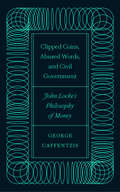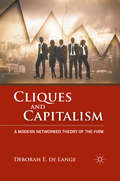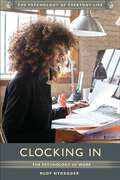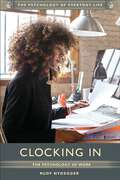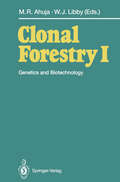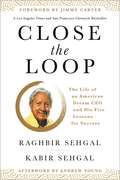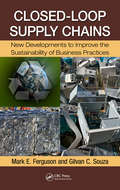- Table View
- List View
The Clinician's Guide to Managed Behavioral Care: Second Edition of The Clinician's Guide to Managed Mental Health Care
by William Winston Norman WinegarManaged care is a revolution impacting the practice of clinicians throughout America. The Clinician’s Guide to Managed Behavioral Care, called “a survival kit” and “must reading,” helps clinicians develop and market professional services attuned to the needs of managed care systems, manage the utilization process, and reshape an office practice or hospital-based program to become more “managed care friendly.” It is newly referenced and updated for clinicians to continue to advocate for their patients and clients.The Clinician’s Guide to Managed Behavioral Care addresses how clinicians can develop and market professional services attuned to the needs of managed care systems, how to best manage the utilization review process, how to re-shape an office practice or hospital-based program to become more “managed care friendly,” and how to best advocate for patients and clients. Readers will understand the history and evolution of attempts to manage mental health care costs and services as well as the emerging clinical, economic, and social trends that will continue to fuel changes in the mental health field in coming years. Importantly, this guide sensitizes readers to the perspectives about mental health care benefits and the treatment field held by the payor community--insurance carriers, HMO’s, and self-insured employers. It allows readers to consider a payor’s view of how professionals can play a crucial role in providing quality services while helping control spiraling mental health care costs--costs that have escalated much faster than other segments of health care.Who can benefit from this book? Practicing psychologists, social workers, psychiatrists, substance abuse counselors, marriage and family therapists, Employee Assistance Professionals, psychiatric nurses, professional counselors, program managers, hospital administrators, and health care marketing professionals will find The Clinician’s Guide to Managed Behavioral Care and invaluable resource.It is often said that in the future, all in the treatment community will be involved in “managing care” and that the most successful clinicians and practices will be those most adept at working with managed care systems on behalf of their patients and clients. This book helps you understand how!Important topics in The Clinician’s Guide to Managed Behavioral Care: the changing marketplace for mental health/substance abuse treatment services assessing market opportunities in light of managed care influences clinical service needs of managed care systems clinical innovations: examples, case studies, vignettes strategies for managing utilization review marketing strategies for office-based practitioners hospital-managed care partnerships contemporary office management strategies to control costs consumers and managed care directory of America’s HMOs directory of America’s Managed Mental Health Care Companies glossary of key terms
The Clinician's Guide to Managed Behavioral Care: Second Edition of The Clinician's Guide to Managed Mental Health Care
by William Winston Norman WinegarManaged care is a revolution impacting the practice of clinicians throughout America. The Clinician’s Guide to Managed Behavioral Care, called “a survival kit” and “must reading,” helps clinicians develop and market professional services attuned to the needs of managed care systems, manage the utilization process, and reshape an office practice or hospital-based program to become more “managed care friendly.” It is newly referenced and updated for clinicians to continue to advocate for their patients and clients.The Clinician’s Guide to Managed Behavioral Care addresses how clinicians can develop and market professional services attuned to the needs of managed care systems, how to best manage the utilization review process, how to re-shape an office practice or hospital-based program to become more “managed care friendly,” and how to best advocate for patients and clients. Readers will understand the history and evolution of attempts to manage mental health care costs and services as well as the emerging clinical, economic, and social trends that will continue to fuel changes in the mental health field in coming years. Importantly, this guide sensitizes readers to the perspectives about mental health care benefits and the treatment field held by the payor community--insurance carriers, HMO’s, and self-insured employers. It allows readers to consider a payor’s view of how professionals can play a crucial role in providing quality services while helping control spiraling mental health care costs--costs that have escalated much faster than other segments of health care.Who can benefit from this book? Practicing psychologists, social workers, psychiatrists, substance abuse counselors, marriage and family therapists, Employee Assistance Professionals, psychiatric nurses, professional counselors, program managers, hospital administrators, and health care marketing professionals will find The Clinician’s Guide to Managed Behavioral Care and invaluable resource.It is often said that in the future, all in the treatment community will be involved in “managing care” and that the most successful clinicians and practices will be those most adept at working with managed care systems on behalf of their patients and clients. This book helps you understand how!Important topics in The Clinician’s Guide to Managed Behavioral Care: the changing marketplace for mental health/substance abuse treatment services assessing market opportunities in light of managed care influences clinical service needs of managed care systems clinical innovations: examples, case studies, vignettes strategies for managing utilization review marketing strategies for office-based practitioners hospital-managed care partnerships contemporary office management strategies to control costs consumers and managed care directory of America’s HMOs directory of America’s Managed Mental Health Care Companies glossary of key terms
Clipped Coins, Abused Words, and Civil Government: John Locke's Philosophy of Money
by George CaffentzisThis book situates John Locke’s philosophy of knowledge and his political theory within his engagement in British monetary debates of the 17th and 18th century. Anchored in extensive archival research, George Caffentzis offers the most expansive reading of Locke’s economic thought to date, contextualizing it within the expansion of capitalist accumulation on a world scale and the universality of money as a medium of exchange. Updated with a new introduction by Paul Rekret, a new foreword by Harry Cleaver and new material by the author, Clipped Coins, Abused Words, and Civil Government continues to make a significant intervention in contemporary debates around the history of capitalism, colonialism and philosophy.
Clipped Coins, Abused Words, and Civil Government: John Locke's Philosophy of Money
by George CaffentzisThis book situates John Locke’s philosophy of knowledge and his political theory within his engagement in British monetary debates of the 17th and 18th century. Anchored in extensive archival research, George Caffentzis offers the most expansive reading of Locke’s economic thought to date, contextualizing it within the expansion of capitalist accumulation on a world scale and the universality of money as a medium of exchange. Updated with a new introduction by Paul Rekret, a new foreword by Harry Cleaver and new material by the author, Clipped Coins, Abused Words, and Civil Government continues to make a significant intervention in contemporary debates around the history of capitalism, colonialism and philosophy.
Clipped Wings: Corporate social and environmental responsibility in the airline industry
by Deborah AncellWithin the developed world, airlines have responded to the advice of advocates for corporate social and environmental responsibility (CSER) to use the intertwined dimensions of economics, society and environment to guide their business activities. However, disingenuously, the advocates and regulators frequently pay insufficient attention to the economics which are critical to airlines’ sustainability and profits. This omission pushes airlines into the unprofitable domain of CSERplus. The author identifies alleged market inefficiencies and failures, examines CSERplus impacts on international competition and assesses the unintended consequences of the regulations. She also provides innovative ideas for future-proofing airlines. Clipped Wings is a treatise for business professionals featuring academic research as well as industry anecdotes. It is written for airlines (including their owners, employees, passengers and suppliers), airports, trade associations, policy makers, educators, students, consultants, CSERplus specialists and anyone who is concerned about the future of competitive airlines.
Clipped Wings: Corporate social and environmental responsibility in the airline industry
by Deborah AncellWithin the developed world, airlines have responded to the advice of advocates for corporate social and environmental responsibility (CSER) to use the intertwined dimensions of economics, society and environment to guide their business activities. However, disingenuously, the advocates and regulators frequently pay insufficient attention to the economics which are critical to airlines’ sustainability and profits. This omission pushes airlines into the unprofitable domain of CSERplus. The author identifies alleged market inefficiencies and failures, examines CSERplus impacts on international competition and assesses the unintended consequences of the regulations. She also provides innovative ideas for future-proofing airlines. Clipped Wings is a treatise for business professionals featuring academic research as well as industry anecdotes. It is written for airlines (including their owners, employees, passengers and suppliers), airports, trade associations, policy makers, educators, students, consultants, CSERplus specialists and anyone who is concerned about the future of competitive airlines.
Cliques and Capitalism: A Modern Networked Theory of the Firm
by Deborah E. de LangeDe Lange suggests a new contextually linked building block model to develop theories of the firm in the field of strategy and organizations. Using this approach, she proposes two models: one that is a realistic American version and another that is a futuristic sustainable model. Both are new networked models that integrate current theories; a review of international corporate governance supports the sustainable firm that solves problems of the current one. Through a revised theoretical lens, the book answers a provocative question surrounding modern corporate America: Who wields the power? In this investigative look at the institutional mechanisms behind who is truly running the show, Cliques and Capitalism seeks to not only explain why the current corporate system fails to function well, but also offers solutions for improved corporate governance through a new sustainable model.
Clocking In: The Psychology of Work (The Psychology of Everyday Life)
by Rudy NydeggerCovering important topics such as job satisfaction, workplace stress, and the changing nature of jobs and careers in the 21st century, this valuable resource explores how working affects us psychologically, for better and for worse and sometimes in imperceptible ways.Although most people go to work Monday through Friday, few stop to think about the central role work plays in our lives. Besides allowing us to provide for the material needs of ourselves and our families, having a job or career can help us to meet new people and stay socially connected, to increase our self-esteem and sense of self-worth, and to allow us to have an impact on the world. But work can also leave us exhausted and stressed, and many people find it difficult to balance their work and personal lives.This clear and accessibly written book in Greenwood's Psychology of Everyday Life series provides readers with an understanding of the important roles work plays in our lives, the many forms work may take, and the ways in which our relationships with work change throughout our lives. The information, presented in an unassuming, easy-to-understand manner, is drawn from classical theory as well as from contemporary research, affording readers a well-rounded understanding of the topic. The book also includes a collection of real-world scenarios to illustrate key concepts as well as scholarly essays offering perspective on current issues and debates related to work in America.
Clocking In: The Psychology of Work (The Psychology of Everyday Life)
by Rudy NydeggerCovering important topics such as job satisfaction, workplace stress, and the changing nature of jobs and careers in the 21st century, this valuable resource explores how working affects us psychologically, for better and for worse and sometimes in imperceptible ways.Although most people go to work Monday through Friday, few stop to think about the central role work plays in our lives. Besides allowing us to provide for the material needs of ourselves and our families, having a job or career can help us to meet new people and stay socially connected, to increase our self-esteem and sense of self-worth, and to allow us to have an impact on the world. But work can also leave us exhausted and stressed, and many people find it difficult to balance their work and personal lives.This clear and accessibly written book in Greenwood's Psychology of Everyday Life series provides readers with an understanding of the important roles work plays in our lives, the many forms work may take, and the ways in which our relationships with work change throughout our lives. The information, presented in an unassuming, easy-to-understand manner, is drawn from classical theory as well as from contemporary research, affording readers a well-rounded understanding of the topic. The book also includes a collection of real-world scenarios to illustrate key concepts as well as scholarly essays offering perspective on current issues and debates related to work in America.
Clockspeed: Winning Industry Control In The Age Of Temporary Advantage
by Charles H. FineIn business today, all advantage is temporary. In order to survive-let alone thrive-companies must be able to anticipate and adapt to change, or face rapid, brutal extinction. In Clockspeed, Charles Fine draws on a decade's worth of research at M.I.T.'s Sloan School of Management to introduce a new vocabulary for understanding the forces of competition and making strategic decisions that will determine the destiny of your company, as well as your industry.Taking inspiration from the world of biology, Fine argues that each industry has its own evolutionary life cycle (or "clockspeed”), measured by the rate at which it introduces new products, processes, and organizational structures. Just as geneticists study the fruit fly to gain insight into the evolutionary paths of all animals, managers in any industry can learn from the industrial fruit flies-such as Internet services, personal computers, and multimedia entertainment-which evolve through new generations at breakneck speed. Applying the lessons of the fruit flies to industries as diverse as bicycles, pharmaceuticals, and semiconductors, Fine illustrates how competitive advantage is lost or gained by how well a company manages dynamic web of relationships that run throughout its chain of suppliers, distributors, and alliance partners.Packed with revolutionary concepts and tools to help managers make key strategic decisions that affect current and future performance, Clockspeed shows, as no other book before it, how the ultimate core competency is mastering the art of supply chain design, carefully choosing which components and capabilities to keep in-house and which to purchase from outside.The consequences of faulty of visionary decisions can be enormous and dramatic. Witness the case of IBM in the early 1980s, when it outsourced key PC components to Microsoft and Intel, unleashing the "Intel Inside” phenomenon and a complete restructuring of the computer industry. Going further, Fine sees the personal computer as merely a component in the vast information-entertainment industry, which evolves at speeds unimagined a few years ago. He uses this "fruit fly” as well to peer into the future of industrial evolution and find practical advice for players in all industries, from automobiles to health care information systems.Clockspeed not only serves up some new "laws” of value chain dynamics, but it also offers recommendations for achieving industry leadership through simultaneous product, process, and supply chain design. In challenging managers to think like corporate geneticists Clockspeed contributes the next creative leap in business strategy.
Clojure for Data Science
by Henry GarnerStatistics, big data, and machine learning for Clojure programmers About This Book • Write code using Clojure to harness the power of your data • Discover the libraries and frameworks that will help you succeed • A practical guide to understanding how the Clojure programming language can be used to derive insights from data Who This Book Is For This book is aimed at developers who are already productive in Clojure but who are overwhelmed by the breadth and depth of understanding required to be effective in the field of data science. Whether you're tasked with delivering a specific analytics project or simply suspect that you could be deriving more value from your data, this book will inspire you with the opportunities–and inform you of the risks–that exist in data of all shapes and sizes. What You Will Learn • Perform hypothesis testing and understand feature selection and statistical significance to interpret your results with confidence • Implement the core machine learning techniques of regression, classification, clustering and recommendation • Understand the importance of the value of simple statistics and distributions in exploratory data analysis • Scale algorithms to web-sized datasets efficiently using distributed programming models on Hadoop and Spark • Apply suitable analytic approaches for text, graph, and time series data • Interpret the terminology that you will encounter in technical papers • Import libraries from other JVM languages such as Java and Scala • Communicate your findings clearly and convincingly to nontechnical colleagues In Detail The term “data science” has been widely used to define this new profession that is expected to interpret vast datasets and translate them to improved decision-making and performance. Clojure is a powerful language that combines the interactivity of a scripting language with the speed of a compiled language. Together with its rich ecosystem of native libraries and an extremely simple and consistent functional approach to data manipulation, which maps closely to mathematical formula, it is an ideal, practical, and flexible language to meet a data scientist's diverse needs. Taking you on a journey from simple summary statistics to sophisticated machine learning algorithms, this book shows how the Clojure programming language can be used to derive insights from data. Data scientists often forge a novel path, and you'll see how to make use of Clojure's Java interoperability capabilities to access libraries such as Mahout and Mllib for which Clojure wrappers don't yet exist. Even seasoned Clojure developers will develop a deeper appreciation for their language's flexibility! You'll learn how to apply statistical thinking to your own data and use Clojure to explore, analyze, and visualize it in a technically and statistically robust way. You can also use Incanter for local data processing and ClojureScript to present interactive visualisations and understand how distributed platforms such as Hadoop sand Spark's MapReduce and GraphX's BSP solve the challenges of data analysis at scale, and how to explain algorithms using those programming models. Above all, by following the explanations in this book, you'll learn not just how to be effective using the current state-of-the-art methods in data science, but why such methods work so that you can continue to be productive as the field evolves into the future. Style and approach This is a practical guide to data science that teaches theory by example through the libraries and frameworks accessible from the Clojure programming language.
Clonal Forestry I: Genetics and Biotechnology
by Mulkh-Raj Ahuja William J. LibbyClonal forestry has come of age. Basic techniques in genetics and biotechnology of other organisms are generally applicable to forest trees. However, there are some differences, in particular in the juvenile- and maturation-related regeneration. Examined here are crucial topics of juvenility, maturation and rejuvenation in clonal propagation of trees. In addition, the genetics of clones, population biology of clonal deployment, propagation and field testing of clones, clone identification, clonal physiology, regeneration and variation in plant tissue cultures, the role of somatic embryogenesis in clonal forestry, and recent developments in biotechnology, including the molecular structure of trees and gene transfer are covered in depth.
Clonal Forestry II: Conservation and Application
by Mulkh-Raj Ahuja William J. LibbyProvided here are both underlying theory and recent results concerning the propagation and use of clones in research and in production forestry. State-of-the-art science and case histories treating production, testing, multiplication and deployment of clones are presented. Agroforestry, urban forestry and christmas-tree farming are covered, along with more traditional multiple-use forestry and high-intensity forestry for biomass, wood and fiber production. Clonal forestry is contrasted to the more recent developments of "family forestry", and the classical tree-improvement approach relying on seed-orchards. The history of clonal forestry is covered with reviews of several centuries experience with Sugi in Japan and poplars in Europe. The impacts and use of clones in the contexts of genetic conservation and biodiversity are discussed, as are the laws and regulations affecting clonal production and deployment.
Close Calls: Managing Risk and Resilience in Airline Flight Safety
by C. MacraeDrawing on extensive and detailed fieldwork within airlines-an industry that pioneered near-miss analysis- this book develops a clear set of practical implications and theoretical propositions regarding how all organizations can learn from 'near-miss' events and better manage risk and resilience.
Close Encounters of a Cultural Kind: Lessons for business, negotiation and friendship
by Richard LewisRichard Lewis - world famous lecturer on intercultural issues and best-selling author of WHEN CULTURES COLLIDE - has collected 50 unique, critical cross-cultural incidents during his encounters in 135 countries around the globe. Some of these anecdotes are humorous, some are poignant, some are mysterious - all are insightful snapshots of the complex tapestry of cross-cultural business. If you're dining with a Finn, negotiating with the Japanese or attempting to climb a mountain with a team of diffident Italians, you need this book."Historically, 'cultural encounters' have often created wars and split people. In this precious little gem of a book, Richard shows how beautifully cultural barriers can be overcome when people meet face-to-face. How we, despite different outlooks, can build bridges across cultural gaps with mindful, respectful and humorous approaches. The stories, told in a vibrant and captivating voice, ranging from thought provoking and insightful to adventurous and hilarious, are a delightful read. The charming characters of broad cultural variety bring the whole world into your hands, making hearts bond over a jolly good laugh.And frankly, - what can be better?"Marit Imeland Gjesme, Founder of CultureCatch®, intercultural training consultancy
Close that Sale!: A guide to top selling techniques, including 52 skill-honing exercises (Teach Yourself)
by Roger BrooksbankLearn how to hone your selling skills and close more sales with this easy to read guide written by someone with extensive experience of every aspect of selling and marketing in the international arena.Based on the five stage OIMCO selling model it covers :-Opening-phase selling skills, including taking control of your selling space and sizing up the customer - Interviewing-phase selling skills, including asking open-style questions , listening actively and triggering your customer's imagination- Matching-phase selling skills , including applying the SELL formula, translating benefits into real money and mastering the art of storytelling-Closing-phase selling skills, including tuning in to buying signals, manufacturing a close and perfecting the art of silence - Objection-handling-phase selling skills, including conditioning yourself positively to objections, pre-handling predictable objections and playing CATCH with every objection raised All neatly summed up in 52 skill honing sections, with skill-enhancing exercises, to perfectly suit a busy life in sales.NOT GOT MUCH TIME?One and five-minute introductions to key principles to get you started.AUTHOR INSIGHTSLots of instant help with common problems and quick tips for success, based on the author's many years of experience.TEST YOURSELFTests in the book to keep track of your progress.EXTEND YOUR KNOWLEDGEExtra online articles at www.teachyourself.com to give you a richer understanding.THINGS TO REMEMBERQuick refreshers to help you remember the key facts.TRY THISInnovative exercises illustrate what you've learnt and how to use it.
Close the Loop: The Life of an American Dream CEO & His Five Lessons for Success
by Kabir Sehgal Raghbir SehgalRaghbir (R.K.) Sehgal has lived the American Dream. He left his native India as a teenager with little money in his pocket. He worked factory jobs in the United Kingdom and eventually moved to the United States. Living in the Deep South in the 1960s, Sehgal experienced discrimination and that redoubled his desire to succeed. He started as a junior engineer at Law Engineering and rose to become Chairman & CEO. Close the Loop is his story told through the voice of his son Kabir Sehgal. This is a profound and personal meditation on hope, persistence, diligence, and resilience. Raghbir also shares his five lessons for success, which you can use to optimize your life.
Close Your Wealth Gap: Financial Lessons to Upgrade Your Life
by Rob LunaSimple and accessible strategies to build personal wealth and improve your life In Close Your Wealth Gap: Financial Lessons to Upgrade Your Life, veteran wealth manager Rob Luna delivers a collection of actionable lessons you can implement immediately to ensure you make the most of the money you make and retire comfortably. You’ll learn everything you need to know about generating personal wealth, from how to understand balance sheets and cash flow statements to constructing a personal portfolio that effectively balances risk and potential reward. The author explains the basics of maximizing your income with side hustles and passive income while, at the same time, increasing the impact of every dollar you earn. You’ll also find: Action plans for every stage of your life, including ways to prepare your children for a lifetime of financial independence and security Explanations of the difference between qualified and non-qualified accounts Strategies for avoiding “bad debt” while intelligently incurring—when necessary—good debtPerfect for young professionals, people with new families, and anyone else with a desire to live well and retire rich, Close Your Wealth Gap is an indispensable recipe for financial security that belongs on the bookshelves of people everywhere.
Close Your Wealth Gap: Financial Lessons to Upgrade Your Life
by Rob LunaSimple and accessible strategies to build personal wealth and improve your life In Close Your Wealth Gap: Financial Lessons to Upgrade Your Life, veteran wealth manager Rob Luna delivers a collection of actionable lessons you can implement immediately to ensure you make the most of the money you make and retire comfortably. You’ll learn everything you need to know about generating personal wealth, from how to understand balance sheets and cash flow statements to constructing a personal portfolio that effectively balances risk and potential reward. The author explains the basics of maximizing your income with side hustles and passive income while, at the same time, increasing the impact of every dollar you earn. You’ll also find: Action plans for every stage of your life, including ways to prepare your children for a lifetime of financial independence and security Explanations of the difference between qualified and non-qualified accounts Strategies for avoiding “bad debt” while intelligently incurring—when necessary—good debtPerfect for young professionals, people with new families, and anyone else with a desire to live well and retire rich, Close Your Wealth Gap is an indispensable recipe for financial security that belongs on the bookshelves of people everywhere.
Closed Circuit Television: CCTV Installation, Maintenance and Operation
by Joe CieszynskiClosed Circuit Television (CCTV) surveillance is one of the fastest growing areas in the security industry. This book is an essential guide for professionals involved the installation and maintenance of CCTV systems, system design, specification and purchasing and the management of CCTV systems. Unlike most existing books on CCTV, this title is not just a discussion of security issues, but a thorough guide to the technical side of the subject - cameras and monitors, video recording, cabling and transmission, installation and maintenance.The concise, accessible text makes it for hard-pressed practitioners and students on training courses.The second edition is fully dual-standard for PAL and NTSC systems. New material in the second edition covers lighting issues and equipment, digital signal transmission, integrated CCTV / intruder alarm systems, CAT5 cabling, digital recording, video printers, ancillary equipment, and a glossary.This book is recommended by SITO (the Security Industry Training Organisation, UK) as suitable for its courses, the City and Guilds 1851 programme, and the underpinning knowledge requirement of Level 3 NVQs from SITO / C & G. Joe Cieszynski is a well known magazine writer and a contributor to the SITO distance learning materials on CCTV. He has extensive experience in the industry and as a lecturer.* Demystifies CCTV technology for installers and managers* Concise, accessible text ideal for hard-pressed practitioners and students* Fully dual-standard coverage for PAL and NTSC based systems
Closed-End Fund Pricing: Theories and Evidence (Innovations in Financial Markets and Institutions #13)
by Seth Anderson Jeffery A. BornClosed-End Investment Companies (CEICs) have experienced a significant revival of interest, both as investment vehicles and as the subject of academic research, over the past decade. This academic research has focused on the nature of closed-end funds' discounts and premiums and on the share price behavior of these firms. The first book by the authors, "Closed-End Investment Companies: Issues and Answers," addresses closed-end fund academic articles published prior to 1991. This second book addresses those articles that have appeared since that time. Closed-End Fund Pricing: Theories and Evidence is designed for the academic researcher interested in CEICs and the practitioner interested in using CEICs as an investment vehicle. The authors summarize the evolution of CEICs, present the factors thought to cause CEIC shares to trade at different levels from their net asset values, provide a complete survey of the recent academic literature on this topic, and summarize the current state of research on CEICs.
Closed-End Funds, Exchange-Traded Funds, and Hedge Funds: Origins, Functions, and Literature (Innovations in Financial Markets and Institutions #18)
by Seth Anderson Jeffery A. Born Oliver Schnusenberg"Closed-End Funds, Exchange-Traded Funds, and Hedge Funds: Origins, Functions, and Literature is a concise and valuable book that will be of interest to individual investors, financial professionals, and academic researchers, alike. It provides a brief history and institutional discussion of these investment companies and also presents a summary of the research on these funds. Investment practitioners will find the book useful as a reference and as a quick refresher on the current state of knowledge regarding each fund type. Equally important, it provides academic researchers with an accurate institutional framework within which to cast their theoretical models, and a point of departure for expanding the empirical analysis for improving our understanding of these funds. All-in-all, this is a very valuable book; I highly recommend it." (John J. Jackson, Professor of Economics, Auburn University) "Professors Anderson, Born, and Schnusenberg provide a valuable service in this monograph. The practical significance of closed-end funds, exchange-traded funds, and hedge funds has increased dramatically in recent years, but all too many academics and investors know little about them. This text presents a carefully-focused and understandable description of these investment vehicles, highlighting the big, unresolved questions, while also including careful and fair accounts of the state of the literature. Nothing extraneous clutters the presentation, but, more importantly, nothing necessary is left out. Highly recommended." (T. Randolph Beard, Professor of Economics and Public Policy, Auburn University) "This book is both useful as a reference book and as an additive, educational overview of ETFs and hedge funds, as well as CEFs. In today’s tumultuous markets, much reference is made to these subjects without a clear understanding of the vehicles, their structure and their history. This is a very timely publication and should be viewed as an important read. The book contains definitive explanations and also includes an excellent summary of past works in this area. Readable, informative and highly useful as a reference source." (Kathleen A. Wayner, President and CEO, Bowling Portfolio Management)
Closed-End Investment Companies: Issues and Answers (Innovations in Financial Markets and Institutions #7)
by Seth Anderson Gustav V. BornClosed-End Investment Companies (CEICs) were the dominant form of investment companies in the United States during the early part of this century, but interest in them declined after the 1929 stock market crash. Since 1985, however, there has been a significant revival of interest in CEICs. A substantial amount of academic research has focused on the nature of closed-end funds, discounts and premiums, and on the share price behavior of these firms, which often results in the prices differing from the net asset value of the shares. This book is designed for the academic researcher interested in CEICs and the practitioner interested in using CEICs as an investment vehicle. The authors summarize the evolution of CEICs, present the factors that cause CEIC shares to trade at different levels from their net asset values, provide a complete survey of the academic literature on this topic, and summarize the current state of research on CEICs.
Closed-Loop Supply Chains: New Developments to Improve the Sustainability of Business Practices
by Mark E. Ferguson Gilvan C. SouzaClosed-loop supply chain activities such as remanufacturing, recycling, dismantling for spare parts, and reverse logistics have helped many companies tap into new revenue streams by finding secondary markets for their products, all while reducing their overall carbon footprint. Written by academic experts, in language that is accessible to practitioners, this authoritative resource examines recent research and case studies of companies running profitable reuse/remanufacture operations in various industries. It illustrates profitable practices in returned and recovered products, clearly explaining how to: design a reverse logistics network, conduct production planning, implement effective marketing strategies, and apply closed-loop supply chain strategies in industries besides manufacturing. From product development to materials to assembly and profitability, this complete resource explores the impact of these processes across all aspects of the supply chain.

